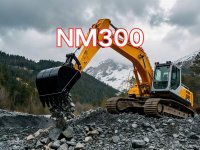

NM300

NM300 is a high-strength wear-resistant steel plate with a Brinell hardness value reaching the 300 HBW grade. It exhibits excellent resistance to abrasion under wearing conditions, making it widely applicable in fields prone to severe wear, such as mining machinery and engineering equipment. Its use effectively extends equipment service life and reduces maintenance costs.
Grade Designation Explanation
The grade "NM300" follows the naming rules of the Chinese National Standard (GB/T 24186):
N: Stands for "Nai", the first pinyin letter of the Chinese word for wear-Nai, resistant.
M: Stands for "Mo", the first pinyin letter of the Chinese word for Mo, wear or abrasion.
300: Represents the specified minimum Brinell hardness value (HBW) for this grade, which is 300.
Therefore, NM300 denotes a "wear-resistant steel plate with a specified minimum Brinell hardness value of 300".
Physical Properties
The core physical properties of NM300 wear-resistant steel are its high hardness and good toughness.
Hardness: The surface Brinell hardness (HBW) is typically ≥300. High hardness is the foundation of its wear resistance.
Strength: Possesses high tensile strength and yield strength, providing strong load-bearing capacity.
Toughness: Maintains good impact toughness alongside high hardness, enabling it to withstand certain impact loads without fracturing easily.
Workability: It can be processed by cold bending, drilling, and welding, but requires techniques and equipment matched to high-hardness materials.
Chemical Composition
The chemical composition of NM300 is designed to ensure its hardness and toughness, primarily consisting of the following elements (exact proportions may vary slightly depending on the manufacturer and process):
Carbon (C): The main strengthening element, increases the steel's strength and hardness.
Manganese (Mn): Improves the hardenability and strength of the steel, and provides some solid solution strengthening.
Silicon (Si): Acts as a deoxidizer and can increase the strength and hardness of the steel.
Chromium (Cr), Molybdenum (Mo), Boron (B), etc.: Often used for micro-alloying, significantly improving the steel's hardenability, wear resistance, and overall mechanical properties.
Phosphorus (P) and Sulfur (S): Typically considered harmful impurities; their content is controlled at low levels to ensure steel purity and toughness.
Application Fields
NM300 is suitable for abrasive wear conditions under moderate impact loads. Common applications include:
Mining Machinery: Dump truck bodies, liner plates for excavator buckets, crusher liners, chutes, hoppers, etc.
Construction Equipment: Blades, cutting edges, and track shoes for bulldozers and loaders.
Material Handling Equipment: Wear parts for screw conveyors, scraper conveyors, and vibrating feeders.
Construction and Others: Liner plates for cement mixers, components for dust collectors, stackers and reclaimers used in large storage yards, etc.
Testing & Production Methods
Testing Methods:
Hardness Test: Primarily uses the Brinell hardness (HBW) test, performed at specific locations on the plate surface to ensure the hardness value meets standards and is uniform.
Mechanical Properties Test: Includes tensile tests (to determine tensile strength, yield strength) and Charpy V-notch impact tests (to determine low-temperature impact toughness).
Non-Destructive Testing (NDT): Ultrasonic inspection can be performed as required to detect internal defects in the steel plate.
Production Method:
NM300 is typically produced using a quenching + low-temperature tempering heat treatment process.
1. Rolling: Initially, controlled rolling and cooling processes are used to obtain the preliminary microstructure and properties.
2. Quenching: The steel plate is heated to the austenitizing temperature and then rapidly cooled (water quenching), transforming the microstructure into high-hardness martensite or bainite.
3. Tempering: Quenching is immediately followed by low-temperature tempering to relieve internal stresses, stabilize the microstructure, and achieve an optimal balance of strength and toughness.
This process is the key technology for obtaining its high hardness and good wear resistance.

Ultrasonic Testing (UT)
A key non-destructive testing technique that uses high-frequency sound waves to detect internal flaws in steel plates. The probe emits sound waves, which reflect when encountering defects such as cracks or inclusions. The receiver captures the echoes, enabling precise determination of defect location and size. With high sensitivity, strong penetration, and fast inspection speed, UT effectively ensures internal quality, widely used in the production of heavy plates, pressure vessel plates, and other high-end products to guarantee safety and reliability.

Magnetic Particle Testing (MT)
A common surface inspection method that magnetizes the workpiece, causing leakage magnetic fields at surface or near-surface defects like cracks or inclusions, which attract magnetic particles to form visible indications. Simple to operate and highly sensitive, MT is suitable for rapid inspection of surface and near-surface flaws in ferromagnetic materials, widely used for online or offline inspection of plate edges, ends, and welds, ensuring product quality and safety.

Penetrant Testing (PT)
A non-destructive method for detecting surface-breaking flaws. A penetrant liquid is applied to the cleaned steel surface, allowing it to seep into defects such as cracks or pores. After removing excess penetrant, a developer is applied, causing the trapped penetrant to bleed out and form visible indications. Simple and cost-effective, PT is suitable for inspecting surface defects in various non-porous materials, commonly used for welds, castings, and complex components, effectively ensuring surface quality of steel plates.








